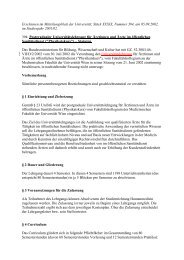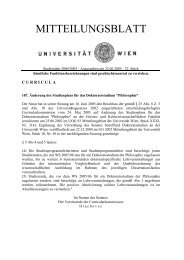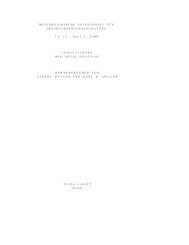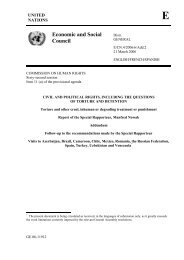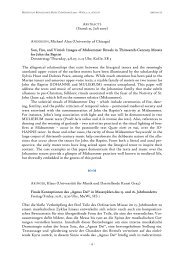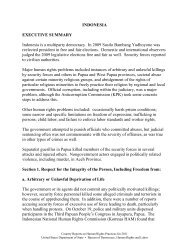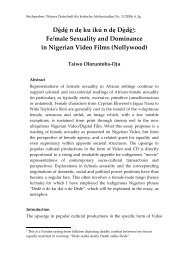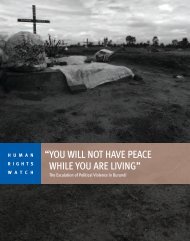Delivered Into Enemy Hands - Human Rights Watch
Delivered Into Enemy Hands - Human Rights Watch
Delivered Into Enemy Hands - Human Rights Watch
You also want an ePaper? Increase the reach of your titles
YUMPU automatically turns print PDFs into web optimized ePapers that Google loves.
Sharif also said he learned the names of some prisoners he was told were there before he<br />
arrived, who he believed were transferred to Guantanamo. 149 They were:<br />
Abu al-Faraj al Libi; 150 Nuqman from Zliten; Abu Ahmad; Abu Omar al<br />
Baidawi, from al Bayda; and Munir al Khomsi, from Khoms.<br />
Sharif said his cell was about 4 x 3 meters. It had a steel door in the middle and a window<br />
with steel bars over the door. On what he described as the backside of the cell there was<br />
also another small window. 151 Shoroeiya did not provide measurements for his cell, but he<br />
said it was slightly bigger, and drew it as slightly bigger than Sharif’s cell. Shoroeiya’s cell<br />
also had a door with a window at the top with bars on it and a slot in the middle of the door<br />
that the guards used to pass food through and check on him occasionally. There was a<br />
small window, about 10 x 30 centimeters that had bars on it too, was about 13 centimeters<br />
from the ground, and provided some ventilation. 152 He added that it also “was a very good<br />
entrance for rats.” 153<br />
In their cells, during the first three to four months of interrogation, which both called the<br />
first “period” of interrogation, each was chained to two iron rings that came out of the wall.<br />
Shoroeiya said the rings were about one meter above the ground. They described being<br />
chained to these rings, sometimes by one arm so that the other arm and both legs were<br />
free (Position 1); sometimes by both arms with both legs free or at times chained together<br />
(Position 2); and sometimes both legs and arms were all shackled to the ring together<br />
(Position 3;). Later, after about a four-month period of intense interrogation and abuse,<br />
Shoroeiya said he was allowed to be unchained in his cell and to walk freely around it.<br />
149 <strong>Human</strong> <strong>Rights</strong> <strong>Watch</strong> telephone interview with Sharif, May 24, 2012.<br />
150 Abu Faraj al Libi, at the time of this writing, was one of four Libyans still held in Guantanamo. See “The Guantanamo<br />
Docket,” New York Times, http://projects.nytimes.com/guantanamo/country/libya (accessed May 27, 2012). Of these five<br />
named, only Abu al-Faraj al-Libi was known to be, at the time of this writing, ever at Guantanamo.<br />
151 <strong>Human</strong> <strong>Rights</strong> <strong>Watch</strong> interview with Sharif, March 14, 2012.<br />
152 Bashmilah described cell conditions very similar to what both Shoroeiya and Sharif described. See Bashmilah Declara-<br />
tion, paras. 56-60 and Exhibit I.<br />
153 <strong>Human</strong> <strong>Rights</strong> <strong>Watch</strong> interview with Shoroeiya, March 18, 2012.<br />
DELIVERED INTO ENEMY HANDS 42




